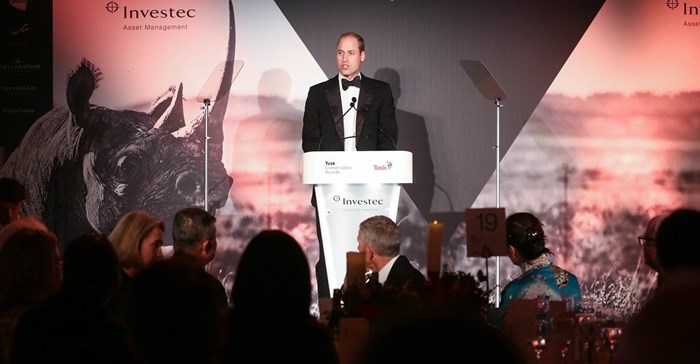Prince William recently spoke at one of the largest illegal wildlife summits ever held in London. He said, "Poaching is an economic crime against ordinary people and their futures."
The quote could have been better. Poachers, after all, are merely the corner boys of the global illegal wildlife trade, the ones who benefit least financially and risk most, usually their lives. They’re ordinary people too, and vilifying them is not getting to the heart of the issue.
William had travelled to Tanzania, Kenya and Namibia in September and October this year, to learn about conservation, and a video of his trip to Tanzania was presented to the attendees. It did not go down well with various NGOs and campaigners who accused the video of promoting a “white saviour” image, given that only one African, a student, spoke to the camera, while the rest of the interviewees were international participants.
Certainly, the team making the video could have better selected the participants and had a wider range of people speak. But that would be putting a sticking plaster over a very serious wound. There are fundamental issues at the heart of conservation, which as a movement was built on inequality and can also perpetuate that same inequality.
In the Guardian’s reporting of the Prince William incident, Dr Mordecai Ogada, director of Conservation Solutions Afrika, said:
Conservation even now, nearly 55 years after Kenya got independence, is still the one arena where Prince William can waltz in to Kenya and tell us he wants us to do this, that or the other … He couldn’t do that in education, banking or other fields, but conservation still has that romantic, Out of Africa feel about it.
This is the bigger issue we should be having a conversation about. Why, decades after the independence of many countries in the Global South, does conservation still have this (neo-)colonial undertone?
Colonial history cannot be ignored
In conservation, history is always present. Across the Global South, researchers like me often work in post-colonial landscapes, areas marked by evictions, forced settlement of herders, the fencing of large swathes of land for private use, or other access restrictions. This, understandably, can foster resentment, disenfranchisement and anger in people living in those regions.
I’ve looked at elephants in South Africa’s Kruger National Park, for instance, where the very name “Kruger” is divisive given he was an Afrikaner leader with a dubious relationship to conservation. There, the government has settled land claims of people who were dispossessed from the park land – for example, in 2016, six communities received R84m (£4.5m). Rates of visiting the park are still recovering from the fact that generations of South Africans who were classified as “non-white” were denied access to large sections of national parks under apartheid.
I recently attended a session on human and wildlife “conflict” and coexistence in southern India. I realised this wasn’t a simple north-south issue. A lot of my Indian colleagues had also been trained under our current ideas about anthropogenic activities threatening biodiversity. This concept can risk bleeding into a perception of humans themselves being the threat. For example, an article in Nature on future threats to biodiversity and paths to prevent them takes on the distinctly misanthropic and negative “humans are killing the planet and all its inhabitants” when reported in the New York Post.
At the same meeting, I heard sentiments way too close for comfort to the “noble savage” trope about communities, in this case local ethnic minorities, who live alongside wildlife. I was disappointed that we seemed to reduce people to bad guys, victims, or romanticise them even though conservation paradigms have supposedly shifted to centring, or at least considering people. As we talked about low-paid immigrant workers on tea plantations, I noticed there weren’t any representatives present. This risks them being “othered” and the psychological distance creating a space for us to accept them facing risks, like being killed by an elephant as they walked to work.
I talked to a journalist colleague in Johannesburg and she shared a similar sentiment, the world wants wildlife stories about a collectively imagined “wild Africa”, not human stories. Because the human stories are complex, less palatable, and potentially threatening to biodiversity. And it’s a shame because Johannesburg is such a vibrant hub of entrepreneurship and creativity. We should be leaping onto that for conservation and collaborating, not seeing it as the opposition.
I am not naïve enough to think that the global distributions of funding and biodiversity map onto each other. In fact, it’s no coincidence that richer countries have lost most of their large mammals in favour of agricultural, industrial and urban development. But how can we manage the funding and conservation efforts without perpetuating the “white saviour” issue?
The answer to me is clear. Conservation can’t be the preserve of people who can afford international travel and to take unpaid internships. We can make choices about communication, participation, training, educating, hiring, salaries, promotion and project leadership (let’s not trap people in assistant positions) and focus on diversity in those. The opening to every conservation text book reads like the fall from the garden of Eden and we have to turn that around; people (and not just white people) are the opportunity.
Skills in spatial analysis, human behaviour, modelling data are vital to a vibrant and technology-driven approach to conservation and these are marketable skills. We need to capture this exceptional human talent, make sure a wide range of people have access to funding and ensure people feel heard in conservation so they choose to make it their career. There are already some incredible leaders and people sharing platforms, and hopefully Prince William will do that in his next speech.
This article is republished from The Conversation under a Creative Commons license. Read the original article.













































